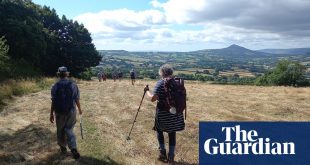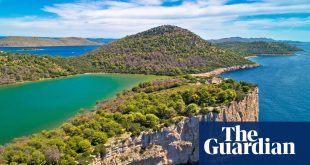The bus runs right beside the Orwell estuary. There are swans drifting among saltmarshes red with autumn samphire, and oystercatchers digging in the pebbles with their long orange bills. It feels an unlikely place to reach easily by public transport, but I stepped off the train 10 minutes ago, after a rail journey to Ipswich through Dedham Vale, an idyllic corner of rural Suffolk often painted by Constable.
Behind me, the cranes of Felixstowe fade into tawny mist and a seasidey smell rises with the sun from seaweed-swathed beaches. A raised path runs past miles of reeds and meadows. I’ve been exploring East Anglia for decades and the Shotley peninsula, where two mighty estuaries converge at the southern end of Suffolk, may be my favourite corner.
Nearby Ipswich has waterfront coffee shops and cultural centres, so you can spend sunny days in the salty wilderness and rainy ones in town. I’m hoping for a varied car-free long weekend of wildlife, walking, culture and food.
Late autumn and winter can be great times to explore without a car, enjoying a stormy landscape through the train window or making the most of the daylight on a bracing station-to‑station walk. And bus travel across England is set to get cheaper from January, when a £60m scheme aims to cap single fares at £2.
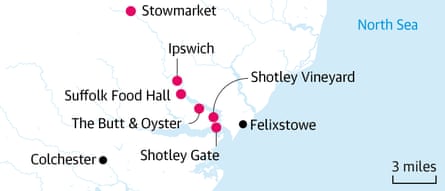
Bus 97 runs every couple of hours from Ipswich station to Shotley Gate at the far end of the peninsula, where more than 150,000 naval cadets trained in the last century on HMS Ganges. From April to October, a little yellow ferry runs across from Harwich Harbour (£4). Arthur Ransome, author of Swallows and Amazons, moved here from the Lake District in 1935 and wove this landscape into later novels; the six-mile path to Pin Mill is waymarked with a boat logo, and called Arthur Ransome’s East Coast.
The leaves are brilliant gold and pale claret on sloping rows of vines 10 minutes from the waterside path. Shotley Vineyard launched its first vintage in 2020 and serves coffee, cake and wine on Fridays, Saturdays and Sundays (10am-2pm). Next door, light pours into Saint Mary’s church, with its painted altar screen and hammerbeam roof.
Back on the coastal walk, a couple of hours’ hike leads up into autumn woods with views over boats, some of them old wrecks that are melting atmospherically into the sea purslane. I have time for a pint of Adnams and plate of wild mushroom linguine at the 17th-century Butt and Oyster before catching a bus from the end of the lane.
Being able to drink is one advantage of car-free travel, and linear walks like this are simpler when there’s no need to get back to a parked car.
A maritime window display near the waterfront says Ipswich has been a seaport since the seventh century. I stroll for 10 minutes past boats and buoys, flint-walled churches and timber-framed houses to Christchurch, a Tudor mansion. The period rooms in this free museum contain intricate doll’s houses, giant globes, and paintings by local boys Constable and Gainsborough. The latest exhibition, Landscape Rebels (until April 2023), includes Turner’s Walton Bridges, newly acquired and thought to be Turner’s first painting based on outdoor oil-paint sketches.
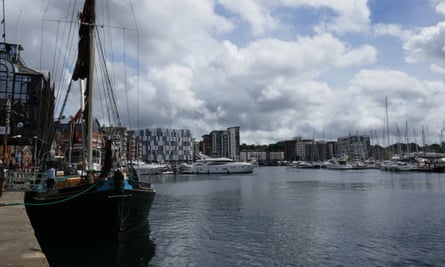
Not far away, the Willis building, an early Norman Foster-designed cliff of undulating dark glass, reflects the evening sunshine and seagulls. I hop on a bus back towards the waterfront and head for the town’s first vegan pub. Hank’s cooks tasty plant-based versions of pub grub and is opening a fast-food joint in Norwich’s new Castle Social street food venue this autumn.
Ipswich has plenty of budget hotels, including the easyHotel, opened near Christchurch Park in 2019 (doubles from £36 room-only). I’ve stayed in most of them over the years, but tonight I’m in the luxurious Salthouse Harbour (doubles from £113 B&B), a 20-minute riverside stroll from the station. The decor is cheerful and wacky; my balcony overlooks the Neptune Marina, and even the bathroom, with its deep freestanding tub, has a harbour view.
Next morning, after a breakfast that includes local apple juice and jam from Tiptree in Essex, I head to the wild Shotley peninsula, taking bus 92 to the village of Holbrook. From here a streamside footpath leads to the Stour estuary, and I walk for six miles, past the sandy beach at Harkstead, along the wooded foreshore with its shell carpets and weather-bleached fallen trees wreathed eerily in feather algae. The estuary has an otherworldly feel at this time of year, when thousands of migrating geese and waders flock to the mudflats.
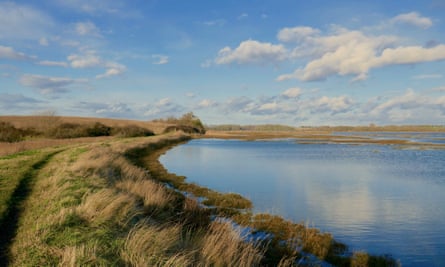
Catching a bus back from the Bristol Arms at Shotley Gate, I stop off next to the huge, rumbling Orwell Bridge for tea at the Suffolk Food Hall, a farm shop-cafe complex, five minutes’ walk down a signed lane from the bus stop. There’s a smell of fresh-baked scones with views of autumn woods across the Orwell. And yes, George Orwell, who lived in Southwold, took his pen name from the river.
On Sundays there are no buses, but Suffolk has scenic train rides too. The local Community Rail Partnerships, volunteers who turn branch-line stations into flowery havens, have devised several station-to-station walks. My favourite is the 10-mile Fynn Valley Walk from Westerfield (one stop by train from Ipswich) to Woodbridge, following sandy paths past Martlesham Creek, where little egrets watch the green waters and plovers scamper over the shingle.
Today, with heavy showers forecast, I’m looking for rainy-day options. Last time I was here in the wet, I took a cruise on the Orwell Lady, which sails from April to October. The trip starts from the harbour, sinking through a mussel-crusted lock to meet the tidal river. Brown-sailed barges float past and the changing weather makes it even more atmospheric: silver-green waves and diving terns and furled sails in the sea mist (cruises from £14).
This time, I’m exploring more museums. The Hold, the University of Suffolk’s new heritage centre, is almost next to the hotel. A stylish building, opened in late 2020, it currently has a free exhibition about Ipswich printers Cowell’s, which produced the first UK edition of Babar the Elephant and helped launch Puffin Picture Books.
In Stowmarket, 15 minutes by train along the Cambridge line, a huge rural-life museum has rebranded itself this year as the Food Museum (£12). It is five minutes’ walk from the station and I meet a food-historian friend there to look around.

The Hedgerow exhibition has poems, photos and foraged tasters from the newly installed kitchen: blackberry jam, rosehip syrup, hawthorn ketchup, nettle tea. Around the site, there’s a medieval barn, a fruiting walled garden, paddocks of goats and a restored weatherboarded watermill, rescued from the Shotley peninsula when a reservoir was built. In the end, the threatened showers hold off until after lunch and we sit outside the museum’s Feast cafe, among tubs of French marigolds, to eat spinach lasagne with a pile of crisp salad leaves and cinnamon-dusted carrot cake fresh from the oven.
Accommodation was provided by Salthouse Harbour Hotel. Rail travel was provided by Greater Anglia; direct trains to Ipswich take about an hour from Cambridge (£24 return) or London Liverpool Street (from £10 single). Day bus tickets for Ipswich, including the Shotley peninsula cost £8.50
 Top Naija News: Nigerian News, Breaking News Nigeria and World News Top Naija News is a daily news publication in Nigeria, delivering the latest breaking news in Nigeria and around the world.
Top Naija News: Nigerian News, Breaking News Nigeria and World News Top Naija News is a daily news publication in Nigeria, delivering the latest breaking news in Nigeria and around the world.

